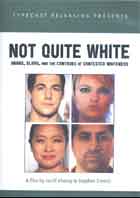
Not Quite White: Arabs, Slavs, and the Contours of Contested Whiteness 2012
Distributed by Typecast Releasing, 3131 Western Ave., Suite 514, Seattle, WA 09121; 206-322-0882
Producer n/a
Directed by Jamil Khoury & Stephen Combs
DVD, color, 24 min.
Sr. High - General Adult
Immigration, Sociology, American Studies, History, Multicultural Studies
Date Entered: 12/18/2012
Reviewed by Cindy Badilla-Melendez, University of St. Thomas, St. Paul, MNA faculty dream video, short and concise, this documentary explores the challenges that Slav and Arab immigrants confront while defining the term “white” as understood by Americans. In the 1800s and 1900s, in order to become a U.S. citizen, immigration laws required that only whites could become citizens, referring to primarily Northern and Western Europeans excluding Slavs and Arabs. Several “degrees” of whites existed. Southern and Eastern Europeans and Jews were considered an inferior race; however they were not classified as African Americans or whites. A complex explanation of who was what and what it meant to be white and who wanted to be white and why are explored in this short film. Told through short interviews with Arab American and Polish American scholars and short scenes from the director’s play WASP (White Arab Slovak Pole), gives a general idea of the conflict of identity, racism, and the concept of what white was and still is.
The most interesting parts of this documentary are the interviews and the clips from the play. This film is not a deep historical documentary, for obvious reasons you cannot show profound details of such a complicated issue in twenty minutes. Jamil interweaves his comments between scenes and unfortunately it gives the film the feel of a high school level production. With a bit more detail and depth on the subject, it would be a great film for a college level class, even though it does make a clear point on the issues.
The picture and sound qualities are good. Recommended for immigration, sociology, American Studies, history, multicultural studies library collections.